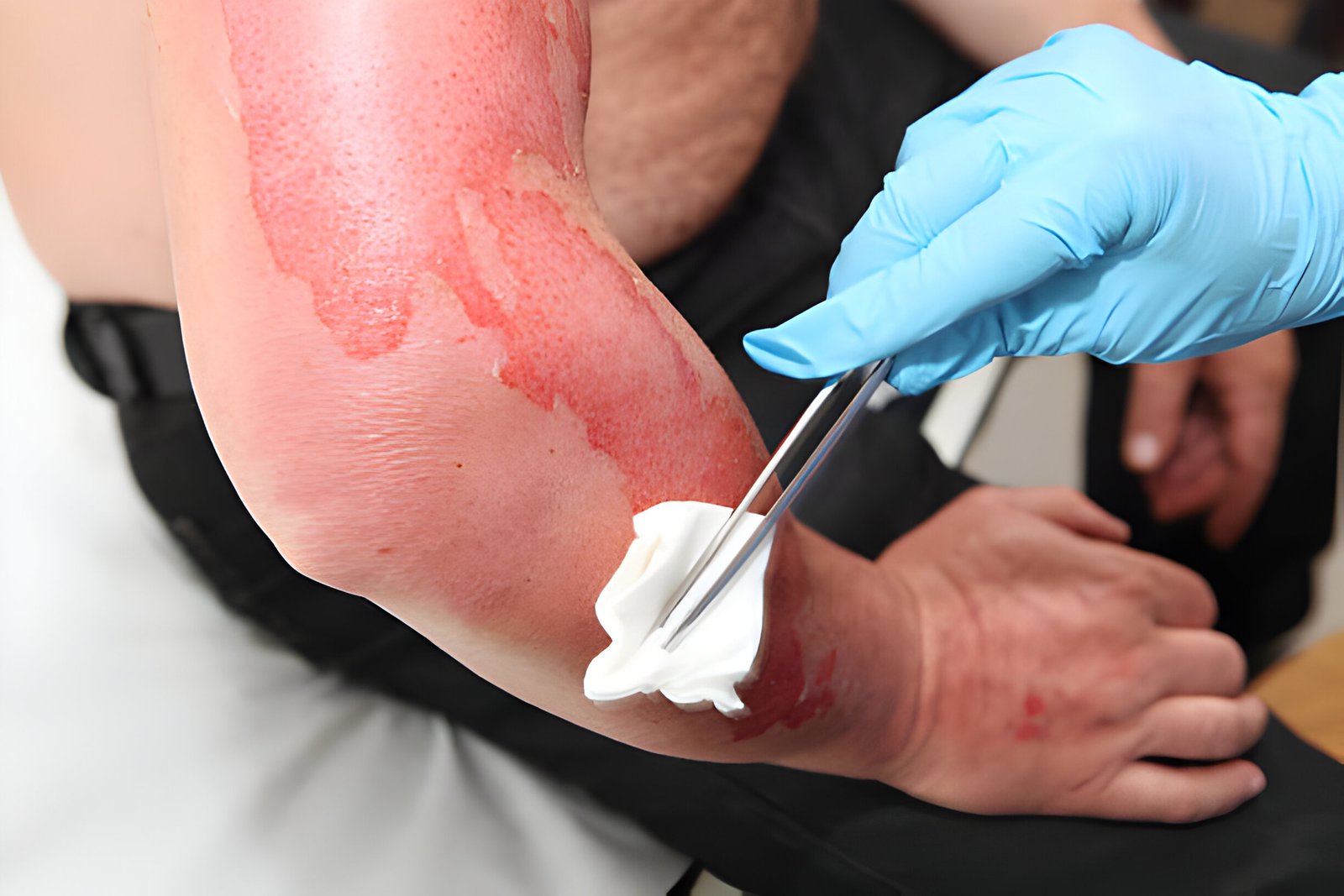Image Credit: GetyImage
Burn injuries are among the most common household accidents, impacting millions globally every year. Understanding what is the first step you should take in caring for a victim with burns is crucial for reducing the severity of injuries and promoting healing. Prompt and appropriate action can be the difference between a minor injury that heals well and a severe one that requires extensive medical treatment. This makes it essential not only to know how to treat a burn but also to recognize the importance of burn self-care and the various treatments available for different types of burns.
This article will guide readers through the initial actions required in treating burns, from assessing the severity to the specifics of burn first aid. We will explore the identification of the burn type—be it thermal, chemical, or electrical—and outline the immediate steps to take, including what to put on a burn and when to treat for shock. Further, we will differentiate between handling major burns, which may require emergency medical assistance, and administering first aid for minor burns. By understanding these procedures, individuals can ensure they provide the best burn care possible, facilitating quicker recovery and minimizing long-term damage.
Identify the Type of Burn
Superficial Burns
Superficial burns, also known as first-degree burns, involve only the epidermis, the outer layer of skin. These burns are characterized by a pink-to-red coloration, absence of blisters, dryness, and moderate pain. They typically heal within 5 to 10 days without leaving scars. Common examples include mild sunburns where the pain and redness subside within a few days, followed by peeling of the affected skin area.
Partial-thickness Burns
Partial-thickness burns are more severe than superficial burns and are classified into two categories: superficial partial-thickness and deep partial-thickness burns. Superficial partial-thickness burns affect both the epidermis and the upper layers of the dermis. These burns cause blister formation, are red, painful, and may weep fluid. They generally heal in 7 to 21 days with minimal scarring but may result in pigment changes. Deep partial-thickness burns extend deeper into the dermis, damaging hair follicles and glandular tissues. These burns are painful to pressure, often blister, and exhibit a mottled coloration. Healing can take two to nine weeks, and these injuries commonly lead to hypertrophic scarring.
Full-thickness Burns
Full-thickness burns, or third-degree burns, penetrate through the entire dermis and affect deeper tissues, potentially including muscle and bone. These burns destroy all layers of the skin, leading to a white, blackened, or charred appearance. The skin becomes dry, leathery, and inelastic, and does not blanch when pressed. Since nerve endings are destroyed, the burn areas may be numb. Full-thickness burns require surgical treatment such as skin grafting and can take more than 8 weeks to heal. These burns carry a high risk of infection and significant long-term physical consequences.
Immediate Steps to Take
Check for Breathing
If the burn victim is unconscious, immediately check if they are breathing. If necessary, begin rescue breathing if trained to do so. Prompt action can be crucial, especially in severe cases where the victim may be in shock or their airways may be compromised.
Remove Jewelry and Tight Clothing
Quickly remove any constrictive items such as jewelry, belts, and tight clothing from the victim, particularly around the burned area and the neck. Burns can cause swelling to occur rapidly, and these items can restrict blood flow and exacerbate the injury. If clothing is stuck to the burn, carefully cut around the adhered fabric to avoid causing further damage.
Cool the Burn
As soon as possible, cool the burn to help reduce pain, swelling, and the risk of further tissue damage. Hold the burned area under cool (not cold) running water for about 10 to 20 minutes. If running water is not available, apply a cool, wet cloth to the burn. Do not use ice or ice water as this can lead to further tissue damage and may increase the risk of hypothermia, especially in cases where large areas of skin are affected.
Handling Major Burns
Handling major burns requires immediate and precise care to prevent complications and promote healing. Here are the essential steps to manage such severe injuries:
Protect from Further Harm
When someone sustains major burns, it’s crucial to protect them from further injury. Ensure the person is no longer in contact with the source of the burn. For electrical burns, confirm that the power source is off before approaching the victim. This initial step prevents additional injuries and is critical for the victim’s safety.
Cover the Burn
Once the individual is safe, the next step is to cover the burn. Use gauze or a clean cloth to loosely cover the affected area. This protects the burn from infection and further irritation. It is important to avoid applying pressure or wrapping the burn too tightly as it can restrict blood flow and exacerbate the injury.
Watch for Symptoms of Shock
Major burns can lead to shock, a life-threatening condition where the body’s organs and tissues don’t receive enough blood flow. Monitor the victim for signs of shock, which include cool, clammy skin, a weak pulse, and shallow breathing. Immediate medical intervention is critical to manage shock effectively.
Handling major burns also involves careful monitoring and medical treatment to manage pain, prevent infection, and facilitate healing. Always seek professional medical help for burns that cover a large area of the body or are deep, as these can have serious complications.
Administering First Aid for Minor Burns
Run Cool Water Over the Burn
For minor burns, immediate cooling of the burn is essential. Place the burned area under running water slightly colder than room temperature for 10 to 15 minutes, or until the pain eases. If running water is not available, a cool, clean, damp cloth can be applied to the burn. This helps reduce pain, swelling, and the risk of scarring. It is important to use cool water rather than ice, as extreme cold can further damage the tissue.
Bandage Loosely
After cooling the burn, it should be covered with a clean bandage. Wrap the burn loosely to avoid putting pressure on the burned skin. This method keeps air off the area, reduces pain, and protects blistered skin. If clothing is not stuck to the burn, remove it carefully. For burns caused by chemicals, remove all clothing that may have the chemical on them. Use a sterile non-stick gauze (petrolatum or Adaptic-type) lightly taped or wrapped over it to protect the burn from rubbing and pressure. Change the dressing once a day to maintain cleanliness and prevent infection.
Avoid Breaking Blisters
Blisters form as a natural protective barrier and help protect against infection. It is crucial not to break blisters. If a blister does break, gently clean the area with water and apply an antibiotic ointment to prevent infection. Cover all open burn areas with non-adherent burn dressing, touching only the edges when applying it to the skin. Then, cover the area with dry sterile gauze. Do not put dry gauze directly on burned areas that have not healed.
Conclusion
Through the detailed exploration of burn injury care, from the initial steps to the specific treatments for superficial, partial-thickness, and full-thickness burns, this article provides a comprehensive guide on the immediate actions required to mitigate damage and promote healing. By identifying the type of burn—thermal, chemical, or electrical—and following the outlined procedures for cooling, protecting, and covering the burn, individuals can effectively reduce the risk of severe complications. Additionally, distinguishing between the need for emergency medical attention for major burns and the correct approach to administering first aid for minor burns is critical for ensuring the best possible outcome for burn victims.
The significance of early and appropriate intervention cannot be overstressed, especially in minimizing long-term damage and enhancing recovery processes. The information presented reinforces the importance of immediate, well-informed responses to burn injuries, emphasizing the role of preparedness in such emergencies. As readers internalize these guidelines, they are equipped not only with the knowledge to care for burn injuries but also with the understanding of the importance of prompt action, which can ultimately make a profound difference in the healing journey. Further research and education in burn care and prevention continue to be vital in improving outcomes for those affected by such injuries.
FAQs
What should be the initial action when treating someone with a burn?
The initial step in treating a burn is to cool the affected area. You should hold the burnt area under cool running water for about 10 minutes. If running water is not accessible or the burn involves the face, you can use a cool, wet cloth to soothe the area until the pain subsides. For burns inside the mouth from hot food or liquids, placing ice in the mouth for a few minutes can help.
What immediate steps should you take to assist a burn victim?
When assisting a burn victim, begin by removing any source of heat. Cool the affected skin area promptly, cover the burn with a sterile bandage, provide pain relief, monitor and treat for shock if necessary, and take steps to prevent infection.
What is the immediate care required for a burn patient?
Immediate care for a burn patient involves the removal of any hot or burned clothing, jewelry, and obvious debris to prevent further injury and to allow for an accurate assessment of the burn severity. Caregivers should be cautious to avoid personal injury during this process.
What is the first step in caring for someone with major burns?
The first step in managing a major burn is to call 911 or seek emergency medical assistance immediately. Ensure that both you and the burn victim are safe and away from any ongoing danger. Move the injured person away from the source of the burn and wait for emergency services to arrive.





One Comment